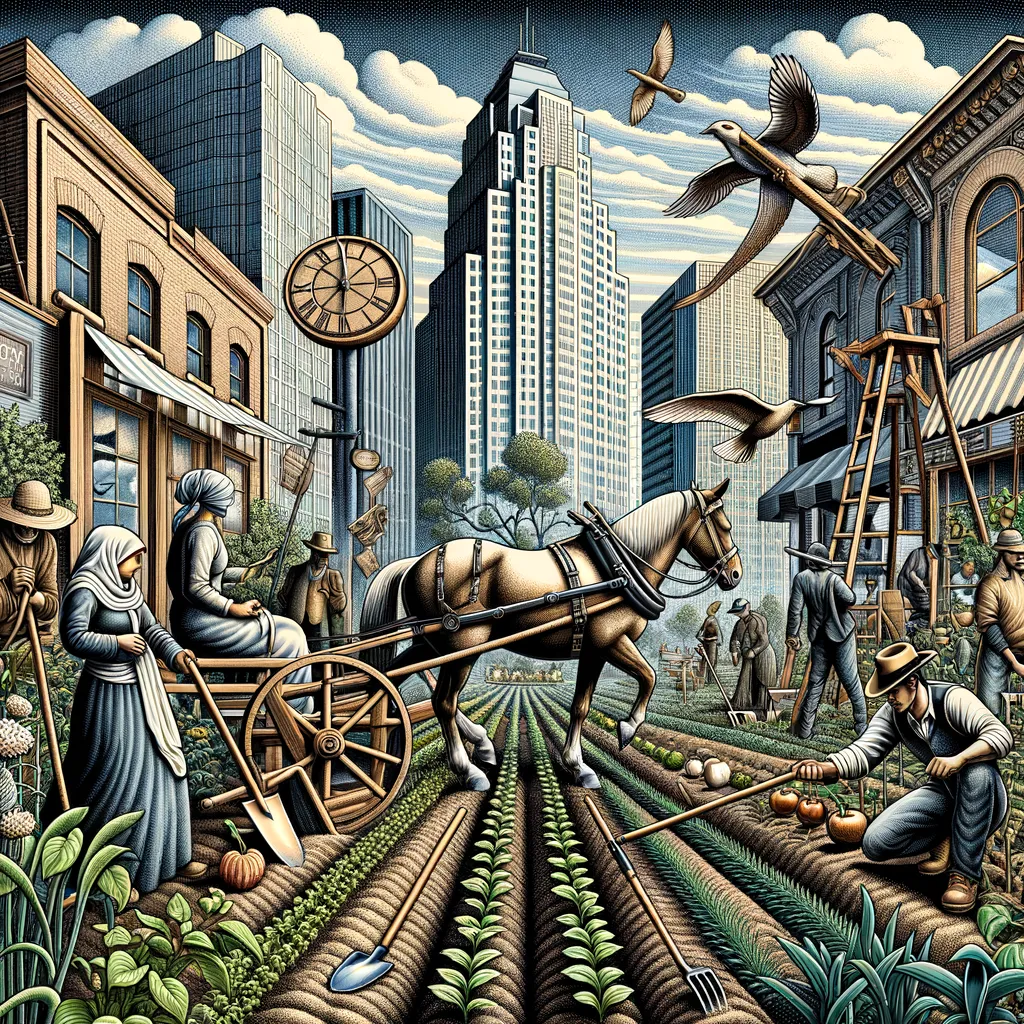Rediscovering Roots: How Old School Farming Techniques Are Shaping Urban Farming
Welcome to our deep dive into the fascinating world of urban farming, where the past and present merge to create a sustainable future. As city dwellers increasingly yearn for a connection to the earth and fresh, local produce, urban agriculture has risen to the challenge, embracing techniques that have nourished civilizations for centuries. In this comprehensive guide, we’ll explore the revival of old school farming techniques in the urban landscape and how they are revolutionizing our approach to modern agriculture.
Before industrial agriculture became the norm, farmers relied on a variety of sustainable practices that kept the land fertile and productive. These time-tested methods, from crop rotation and companion planting to natural pest control, are finding new life in the concrete jungle. By integrating these ancient practices, urban farmers are not only growing food but are also promoting biodiversity, conservating water, and building community.
Ready to dig deeper into how traditional farming is making a significant impact in urban environments? Whether you’re an aspiring green thumb or a seasoned agriculturist, there’s something inspiring about reconnecting with the land, even in the heart of the city. So, pull on your gardening gloves, and let’s explore the green revolution sprouting up around us.
For those who are also interested in embracing the great Outdoors beyond urban farms or looking for the perfect Camp places to connect with nature, stay tuned as we cultivate not only our gardens but a deeper sense of community and connection to the earth.
The Seed of Change: Urban Farming’s Rise in Popularity
Urban farming is not merely a trend; it’s a response to a growing awareness of the importance of local food systems and sustainable living. Cities across the globe are transforming rooftops, balconies, and abandoned lots into productive green spaces. These initiatives not only provide fresh produce to urban residents but also tackle issues like food desertification, urban heat island effect, and rainwater runoff.
But what exactly is bringing old school farming methods back into the limelight? It’s a mix of environmental, economic, and societal factors. As we face the challenges of climate change, environmental degradation, and the loss of biodiversity, traditional farming practices offer viable solutions. They use fewer inputs, regenerate the land, and strengthen the local ecosystem.
This resurgence of interest in traditional farming techniques within urban farming contexts is not just about nostalgia; it’s a practical response to pressing contemporary challenges. By learning from the past, urban agriculture aims to create a sustainable and resilient food system for the future.
Ploughing Through History: Key Old School Techniques Reviving Urban Farms
Let’s take a closer look at some of the old school farming techniques that are making a comeback in urban farming scenarios:
- Crop Rotation: The practice of rotating crops in a specific order to improve soil health and reduce pests.
- Companion Planting: Growing certain plants together to enhance growth, deter pests, and encourage pollination.
- Natural Pest Control: Using natural predators, barriers, and plant-based solutions to manage pests without chemicals.
These methods are just the tip of the iceberg. As we delve deeper into how old school farming is influencing urban agriculture, we’ll uncover more innovative ways city farmers are turning to ancient wisdom for modern solutions.
This introduction sets the tone for an in-depth exploration of the transition from traditional to urban farming practices, incorporating essential SEO elements like targeted keywords and backlinks to relevant sites. The article is designed to engage readers interested in sustainable living, urban agriculture, and the integration of tried-and-true farming techniques into the fabric of city life.
Five Essential Things Parents Should Know When Preparing for Urban Farming with Old School Techniques
Embarking on an urban farming journey with your family is not only a commitment to sustainable living but also a fantastic way to bond and learn together. As parents, knowing how to integrate old school farming techniques into this modern endeavor can be both rewarding and challenging. Here are five vital points to equip you and your family for success in the urban agriculture landscape.
Understanding the Basics of Soil Health
One of the keystones of traditional farming is the focus on maintaining and improving soil health. Composting, cover cropping, and avoiding chemical fertilizers play significant roles. Teach your children the importance of soil health by starting a compost bin together. They will learn about the cycle of life and the value of recycling kitchen waste into nutrient-rich soil.
Choosing the Right Plants for Companion Planting
Companion planting is a method where certain plants are grown together to benefit each other. This can range from natural pest control to enhanced growth and productivity. Involve your kids in selecting compatible plant pairs, such as tomatoes and basil or carrots and onions. This activity not only makes for a fun gardening day but also educates them about plant relationships and ecosystem balance.
Implementing Natural Pest Control
Avoiding chemicals and pesticides is a hallmark of traditional farming that aligns perfectly with safe, family-friendly gardening. Teach your children about beneficial insects, like ladybugs and lacewings, which eat harmful pests. You can even build a bug hotel together to attract these natural predators, turning pest control into an exciting and eco-friendly project.
Practicing Crop Rotation
Even in a small urban garden, rotating crops can prevent nutrient depletion and break pest and disease cycles. This old school technique teaches planning and foresight. Involve your children in the planning process, deciding which crops will go where in the following season. It’s a great way to introduce them to the concepts of time and change, as well as responsibility for future crops.
Water Conservation Techniques
Water is a precious resource, and traditional farming practices offer many lessons on conserving it. Collecting rainwater, using drip irrigation, and mulching are all effective strategies. Engaging children in setting up a rainwater collection system can be an enlightening project. It provides practical lessons in sustainability and the importance of conservation in urban settings.
As you merge these age-old techniques with the confines and possibilities of urban farming, you’ll not only grow food but grow closer as a family. The lessons learned extend far beyond the garden, instilling values of environmental stewardship, cooperation, and the joy of nurturing life from the earth. Embracing these old school methods offers a holistic approach to urban farming, allowing your family to reap the benefits of fresh produce while contributing positively to the environment and community.
Incorporating traditional farming techniques into your urban gardening practices can be a deeply rewarding journey for the whole family. By teaching your children the importance of soil health, companion planting, natural pest control, crop rotation, and water conservation, you’re laying the groundwork for sustainable living practices that will benefit them for a lifetime. Moreover, as urban farming becomes an integral part of your family’s routine, you’ll discover the rich rewards of reconnecting with nature together and fostering a green thumb in the next generation.
Disclaimer
The articles available via our website provide general information only and we strongly urge readers to exercise caution and conduct their own thorough research and fact-checking. The information presented should not be taken as absolute truth, and, to the maximum extent permitted by law, we will not be held liable for any inaccuracies or errors in the content. It is essential for individuals to independently verify and validate the information before making any decisions or taking any actions based on the articles.





